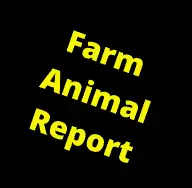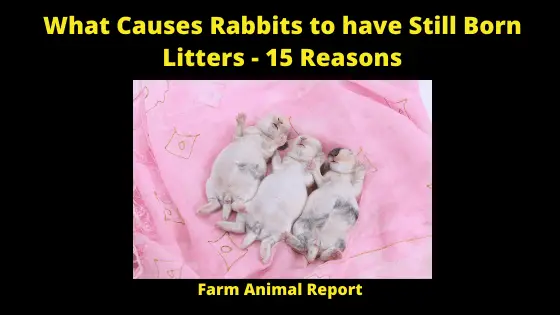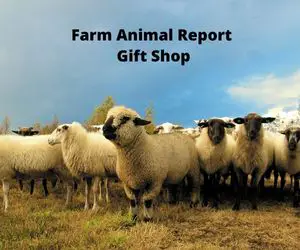Stillborn Rabbit – As a general rule, there can be several common reasons for still born kits. Within large rabbit litters, there is intensive competition among littermates for dam’s milk and thermally favorable positions in the litter huddle, and weak kits of low birth weight are more likely to die because of starvation. In addition to the size of the nursing litter, kit body mass, litter homogeneity, and doe body mass and its physiological condition could affect its caring ability and subsequently kit survival.
Stillborn Rabbit – Rabbit Giving Birth to Dead Babies
What Causes Rabbits to have Still Born Litters. Stillbirth is common and its rate is high in rabbits and the early postnatal days are critical to the survival of kits. Within large rabbit litters, there is intensive competition among littermates for dam’s milk and thermally favorable positions in the litter huddle, and weak kits of low birth weight are more likely to die because of starvation. Rabbit Giving Birth to Dead Babies – Still Born Litters, Stillborn Rabbit, Stillbirth
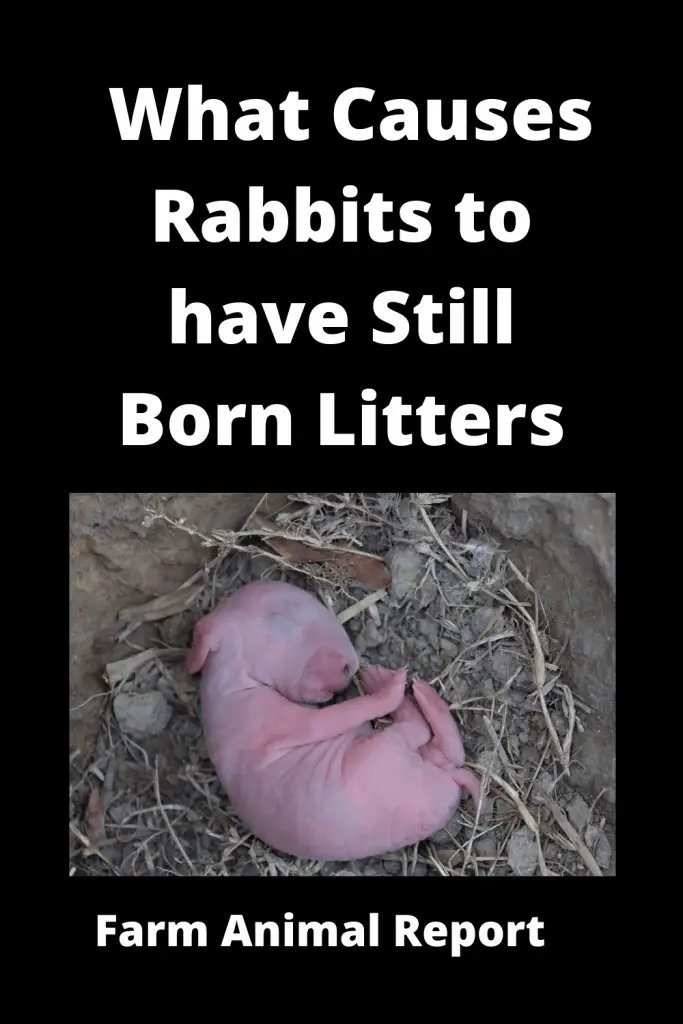
In addition to the size of the nursing litter, kit body mass, litter homogeneity, and doe body mass and its physiological condition could affect its caring ability and subsequently kit survival. Also, seasonal differences in kit losses (baby) have been recorded.
You can also Read our Guide –18 Ways to Make Money by Rabbit Farming—Extensive Guidelines for Rabbit Farmers
Check Out Amazon for Resources about Breeding Rabbits
Even if the mortality rate is low nowadays, the discovery of dead newborn rabbits is always unpleasant and is accompanied by a questioning of breeding practices. The breeding of show rabbits is a delicate balance between the genetic make-up of a given breed, genetic and environmental factors, and the increased susceptibility of a particular breed to congenital or juvenile hereditary diseases or defects.
Hygiene, diet, and external factors, such as maternal behavior of the pregnant doe during gestation and after kindling, litter size, birth weight of the newborn, or weather conditions also play an important role.
All of these factors will affect the health of the doe and the survival rate of her newborns.
The postpartum mortality rate of newborns is not a definitive value. The average rate is generally low, less than 10%. It may nonetheless reach 50% or even 100% of a litter during the first two weeks of life of the newborn. The mortality rate of 4 to 8 weeks old rabbits remains high and then decreases to near zero in rabbits aged 3 months or older.
The most common causes of death are, in decreasing order: the abandonment of the litter, unknown causes, cannibalism and mutilation of the newborn, insufficient milk production or lack of feeding the offspring, crushing in the nest, sickness or weak or malformed newborn (runts). Finally, the death of the doe may result in the death of her offspring.
Listeriosis in Rabbits
This condition has a sudden onset of symptoms that often result in death or abortion of an unborn rabbit. The disease causes severe symptoms that are often not treatable and therefore are very serious. There are four ways in which this disorder presents itself.
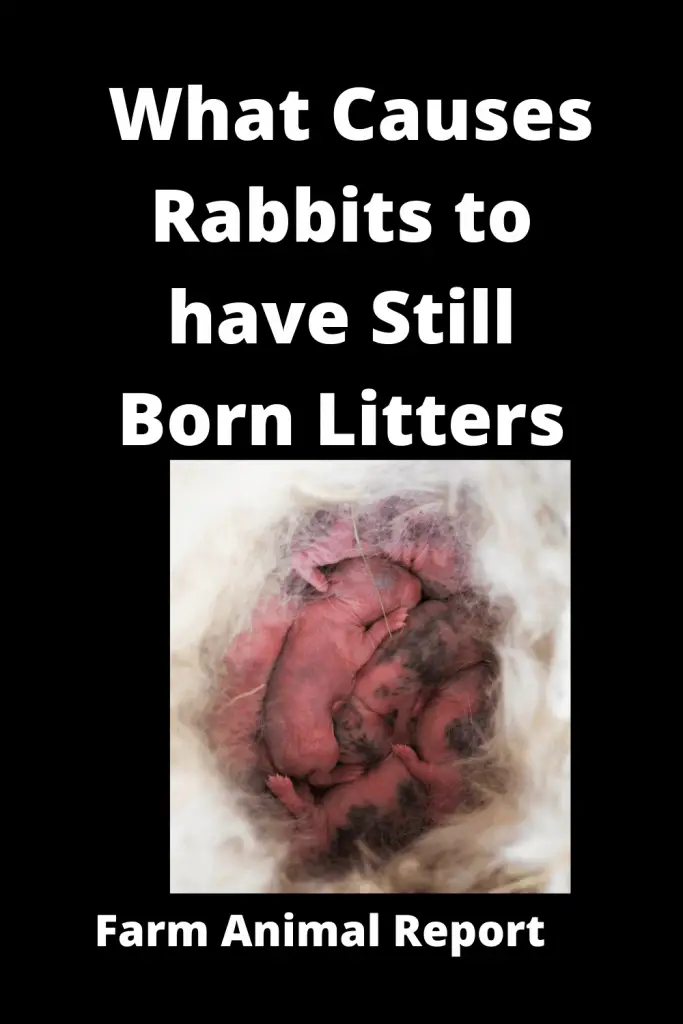
Due to the symptoms coming on suddenly, your rabbit may be fine one day, and the next, have severe and debilitating symptoms without warning. He may appear to have paralysis, eye inflammation, or walking in circles. If your rabbit is pregnant and aborts her fetus or gives birth to a stillborn, it may not be recognized right away that there is something going on.
Listeriosis is a bacterial blood infection that can be found in soil, water, and mud.
It is a widespread bacteria (Listeria) and can be passed to humans. (treated with medicine)
See Amazons Selection of Rabbit Hutches
Symptoms of Listeriosis in Rabbits (stillbirth)
- You may notice an overall lack of energy and movement
- Your rabbit may lose his appetite and stop eating
- Depression
- Fever
- Difficulty standing up, moving and he may collapse and be unable to get back up
- Due to the paralysis, your rabbit may begin to salivate excessively
- Your rabbit may begin to develop paralysis of one side of his face; this can include his eye, nostrils, mouth, and ear drooping
- You may notice your rabbit walking or hopping in a circle only going one way
- Your rabbit may corner himself and have difficulty figuring out where he is or how to move out of his space
- This may be an abortion or birth to a stillborn
- Diarrhea
- Including a cough or breathing concerns
Types of Listeriosis in Rabbits ( baby)
There are four ways in which this disease presents itself: encephalitis, septicemia, abortion and perinatal deaths, and mastitis.
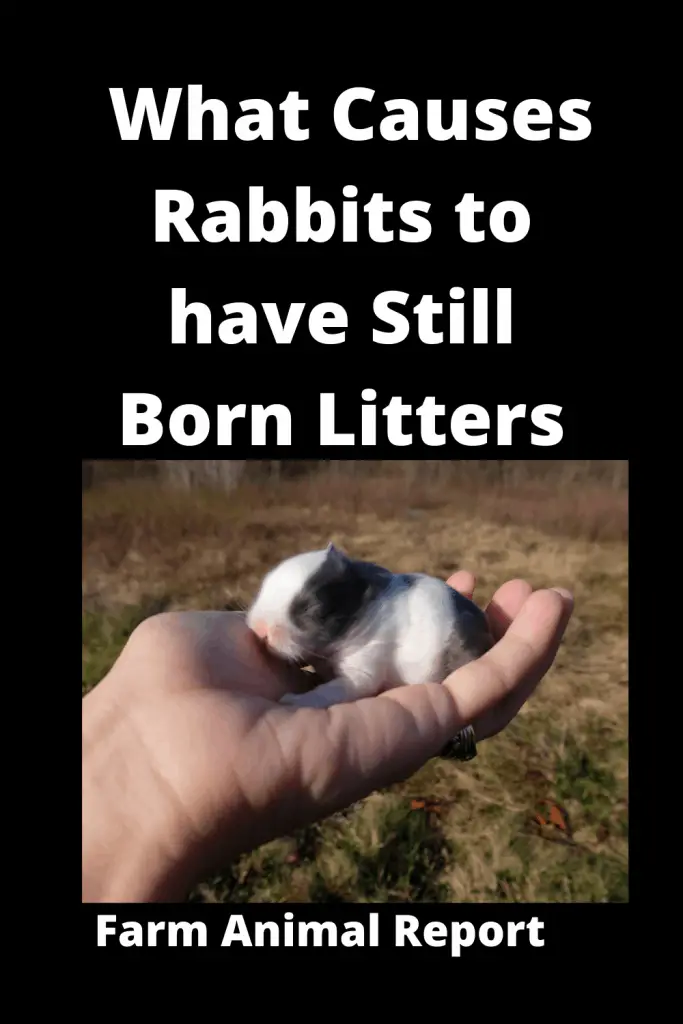
Encephalitis
- Happens in older adults
- This is an inflammation of your rabbit brain caused by the bacteria
Septicemia
- This is an infection of multiple organs in your rabbit
- Rabbits are more susceptible to this presentation
- Rarely will your rabbit present with symptoms
- Often the animal is found already deceased
Abortion or Perinatal Death
- There are typically no other symptoms besides the loss of fetus
- Most common towards the end of pregnancy
Mastitis
- Very rare
- Antibiotics will not help in these cases (medicine)
Causes of Listeriosis in Rabbits – (Treated with Medicine)
The causes are based on how your rabbit comes into contact with the bacteria:
- Listeria is found worldwide
- If your rabbit were to eat any of the following that is contaminated – Soil, plants, mud, streams
- Poor quality silage results in most contamination
- Can be passed on by your rabbit coming into contact with infected feces
- Typically presents at high times of stress
- Found in younger animals, 1-3 years of age more often
Diagnosis of Listeriosis in Rabbits
If you suspect your rabbit may have listeriosis,
it will be important to get him to his veterinarian as soon as possible.
Definitive diagnosing only happens with a tissue sample testing for the listeria bacteria. This is often done on an aborted placenta, fetus, or brain tissue.
However, other bodily fluids and tissue samples can be taken to test for the bacteria. Your veterinarian will need to know where your rabbit came from and if he came into contact with any ill animals to your knowledge.
Treatment of Listeriosis in Rabbits
Once your veterinarian has identified listeriosis, treatment options are available. The treatment of choice is antibiotics. However, treatment needs to be implemented early in the disease or the success is not as great. There is not much information on which antibiotics are used to treat this disease due to the fact that often this disease is found after an animal has died.
Recovery of Listeriosis in Rabbits
If antibiotics are successful in treating the disease, follow up appointments will be necessary to monitor any long-term damage done. Your veterinarian will discuss these needs with you once you bring him in. Changes made to your rabbit environment will include keeping him away from other animals who may be infected with the disease to minimize contamination.
Prevention is the best policy for this bacterium. Preventing your rabbit from eating any hay or feed that has spoiled and providing him with clean, non-contaminated water will help slow down the spread of the bacteria. You can also keep your rabbit away from areas that you are not sure are clean and free of the bacteria
as well.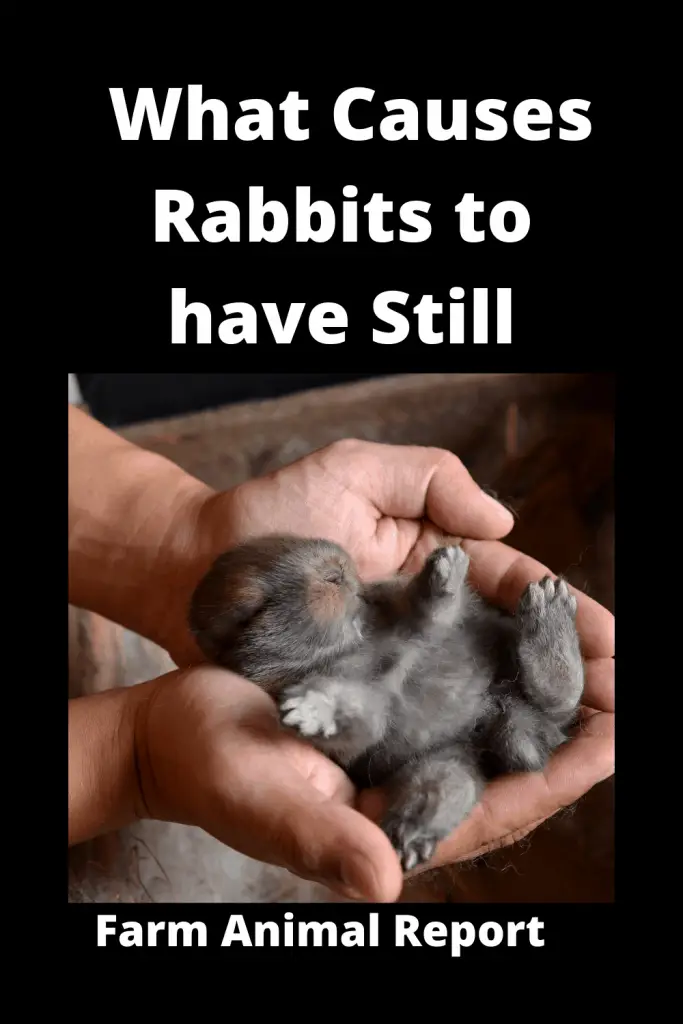
Rabbit Syphilis
Rabbit syphilis, also known as treponematosis, vent disease, or venereal spirochetosis, is caused by the bacterium Treponema cuniculi. This is not a zoonotic disease and can be passed by direct and sexual (venereal) contact. Transmission is through direct contact with infected skin or from an infected dam to kits at birth. Incubation periods are long, lasting up to 10 to 16 weeks
Symptoms of Rabbit Syphilis
- It is a self-limiting disease; carriers may be asymptomatic until stress occurs.
Other symptoms include the following
- Lesions on the skin of the perineum and genital.
- Facial lesions around the chin, lips, nostrils, and eyelids.
- Inguinal lymph nodes may be enlarged.
Affected female rabbits can also have the following symptoms
- Inflammation of the uterus (metritis)
- Abortion
- Neonatal death
Bucks are often asymptotic carriers and may have small star-shaped stars on their scrotum. Rabbits with syphilis are effectively treated with injections of penicillin.
Normal Behavior at Parturition in Rabbits
Under normal conditions, spontaneous parturition in the laboratory rabbit occurs on the 30th to 32nd day after the mating. The mean duration of pregnancy is 31 days, but there is quite a large variation, from 28 to 35 days, which is largely ascribable to differences in litter size.
It is well established that large litters are born earlier than the 31st day and small litters after a longer pregnancy; most litters of one or two young are born after the 33rd day. At the end of pregnancy, there is marked hair loosening which is controlled by endocrine factors. In the wild, many does dig a new nest cavity within 24 hours of delivery.
Domestic rabbits do the same if given the opportunity but this is impossible under normal laboratory conditions. A female rabbit in a cage will none the less exhibit digging behavior and scratch at the bottom of the cage for many hours. If the animal is placed in a cage with straw or hay, it will make a nest by heaping straw in one corner, after which the doe will scratch a hole and put her head under the nesting material, sometimes throwing it over her back.
The preparation of a straw nest usually takes 2-7 hours. As soon as it is ready, the doe leaves the nest and starts to pluck loosened hair from her coat; almost every doe holds a couple of straws in her mouth whilst doing this. The plucked hair is carried into the nest and the procedure repeated several times; the amount of hair plucked varies with the individual doe. Hair plucking seldom lasts longer than l-2 hours.
Immediately after plucking, the doe collects lost hair from the floor of the cage and carries it into the nest, where she starts to give birth to the young. Generally, there is no marked pause between the end of plucking and the beginning of the expulsion phase of parturition.
During parturition, the doe sits in a bent position so that she can lick the genital region and the first part of the young to appear in about 60 % of cases, the head. Expulsion of each of the young occurs very quickly and usually, only one or two abdominal straining movements can be observed. Generally, the young are born in ruptured membranes.
The placenta may be expelled at the same time as the young, or follow soon afterward. Almost always the umbilical cord breaks inside the birth canal. The rupture occurs at a preformed spot in the cord and the umbilical sphincter muscle plays an important role in this procedure. The mother washes the newborn rabbit and eats the placenta.
Normal expulsion of the whole litter seldom takes longer than ten minutes. This extremely rapid delivery is peculiar to the rabbit and is possible because the bony birth canal has extraordinarily large dimensions in relation to the size of the full-term fetus. If the rabbit is anxious due to the presence of an unknown observer of changes in its environment, parturition can be delayed for a long time.
Such suppression of labor activity is a phenomenon well-known from several species of mammals. Immediately after delivery the mother covers the young with hair and straw and leaves the nest. It was necessary to remove the animals from their own cages in order to record intra-uterine pressure: they were placed in a roomy basket filled with straw and were not restrained in any way.
Most animals rapidly became accustomed to this new environment during the course of recording or when recordings were made on several subsequent days, but some nervous animals showed disturbances of the normal behavior pattern Abnormal behavior has therefore been taken into account when assessing intra-uterine pressure records.
Conclusion
In asking the question of why our rabbits are born Stillborn, there are many reasons and final determination can be examined by a Veterinarian. The most common reasons are
- Abandonment
- Cannibalism
- Mutilation of Newborns
- Insufficient Milk Production
- Hypothermia
- Crushing in Nest
- Sickness
- Malformed newborns/Runts
- Death of the Doe
Rabbit Meat Profitability Table
| Rabbits | Rabbits Born | Lbs Meat / Year | Average Price / LB | Total Revenue Possible |
|---|---|---|---|---|
| 1 | 84 | 252 | $ 8.00 | $ 2016 |
| 2 | 168 | 504 | $ 8.00 | $ 4032 |
| 5 | 420 | 1260 | $ 8.00 | $ 10,080 |
| 10 | 840 | 2520 | $ 8.00 | $ 20,162 |
| 20 | 1680 | 5040 | $ 8.00 | $ 40,320 |
| 30 | 2520 | 7560 | $ 8.00 | $ 60,480 |
| 40 | 3360 | 10,080 | $ 8.00 | $ 80,640 |
| 50 | 4200 | 12,600 | $ 8.00 | $ 100,800 |
| 100 | 8400 | 25,200 | $ 8.00 | $ 201.600 |
| 200 | 16,800 | 50,400 | $ 8.00 | $ 403,200 |
Rabbit Giant Angora Fur Profitability Table
| Rabbits | Rabbits Born / Yr | 0z wool / Year 40 OZ / Rabitt | Average Price / oz $10.00 | Feed Cost / Yr $ .30 per day / $ 110 per Year | Total Revenue Possible |
|---|---|---|---|---|---|
| 1 | 84 | 3,360 | $ 33,600 | $ 9,240 | $ 24,360 |
| 2 | 168 | 6,720 | $ 67,200 | $ 18,480 | $ 48,720 |
| 5 | 420 | 16,800 | $ 168,000 | $ 46,200 | $ 121,800 |
| 10 | 840 | 33,600 | $ 33,6000 | $ 92,400 | $ 243,600 |
| 20 | 1680 | 67,200 | $ 672,000 | $ 184,800 | $ 487,200 |
| 30 | 2520 | 100,800 | $ 1,008,000 | $ 57,200 | $ 950,800 |
| 40 | 3360 | 134,400 | $ 1,344,000 | $ 369,600 | $ 974,400 |
| 50 | 4200 | 168,000 | $ 1,680,000 | $ 462,000 | $ 1,218,000 |
| 100 | 8400 | 336,000 | $ 3,360,000 | $ 924,000 | $ 2,436,000 |
| 200 | 16,800 | 672,000 | $ 6,720,000 | $ 1,848,000 | $ 4,872,000 |
Average Giant Angora Weight 10lb
40 Oz shaved Fur per Rabbit per Year
Feed $ .30 per day for 10lb Rabbit
Rabbit Poop Profitability Table
| Number Rabbits | Manure / day / .5lb | Manure / lbs Week | Manure /lbs Year | |
|---|---|---|---|---|
| 1 | .5 | 3.5 | 182 | |
| 2 | 1 | 7 | 364 | |
| 3 | 1.5 | 10.5 | 546 | |
| 4 | 2 | 14 | 728 | |
| 5 | 2.5 | 17.5 | 910 | |
| 10 | 5 | 35 | 1820 | |
| 20 | 10 | 70 | 3640 | |
| 30 | 15 | 105 | 5460 | |
| 40 | 20 | 140 | 7280 | |
| 50 | 25 | 175 | 9100 | |
| 100 | 50 | 350 | 18,200 | |
| 200 | 100 | 700 | 36,400 | |
Breeds of Rabbits FAQ
| Breed of Rabbit | Origin | Weight | Purpose | Kits / Litter | Breed association |
|---|---|---|---|---|---|
| New Zealands | California | 5 kg 11 lbs | Meat | 8 | American Federation New Zealand Rabbit Breeders Assoc |
| Californias | California | 3 kg 7-10 lbs | Meat | 6 - 8 | California Rabbit Breeders |
| Rex | France | 4.5 kg 10.5 lbs | Meat | 2 - 4 | National Rex Rabbit Club |
| Satins | Michigan | 4 kg 9.5 lbs | Meat | 2 - 4 | American satin Breeders Association |
| Paliminos | American | 5.4 kg 12 lbs | Meat | 6 -8 | Palimino Rabbit Breeders Association |
| English Angora | England | 2-3 kg 5-7 lbs | Wool | 6 - 8 | National Angora Breeders |
| French Angora | France | 4.5 kg 10.5 lbs | Wool | 6 - 8 | National Angora Breeders |
| Giant Angora | Turkey | 4.5 kg 9 - 10 lbs | Wool | 6 - 8 | National Angora Breeders |
| Satin Angora | Turkey | 4.5 kg 6 - 10 lbs | Wool | 6 - 8 | National Angora Breeders |
| Mini Lop | UK | 3 kg 5.5 lbs | Dwarf | 2 -3 | American Mini Lop Rabbit Club |
| Dutch Dwarf | Netherlands | 1 - 2 kg 2,5 lbs | Dwarf | 2 - 4 | American Netherland Dwarf Rabbit Club |
| Pygmy Rabbit | North American | 500 grams 1 lb | Dwarf | 6 | ? |
| Britania Petite | UK / Polish | 700 grams 1 1/2 - 2 lbs | Dwarf | 2-3 | American Britiania Petite Rabbit Society |
Size
Purpose
Litter Size
Breed Association
Rabbit Breeder Associations
| Rabbit Association | Location | Link |
|---|---|---|
| American Breeders Association | United States | ARBA |
| House Rabbit Society | California | HRS |
| Ohio States Rabbit Breeders Association | Ohio | OSRBA |
| Livestock Conservancy | North Carolina | LC |
| Rabbit Welfare Association and Fund | United Kingdom | RWA |
| British Rabbit Council | United Kingdom | BRC |
| European Association of Rabbits.... | Europe | EAP |
| Australian National Rabbit Council | Australia | ANRC |
| Australian Rabbit House Society | Australia | ARHS |
| ARBA - Rabbit Shows | United States | ARBA - Shows |
